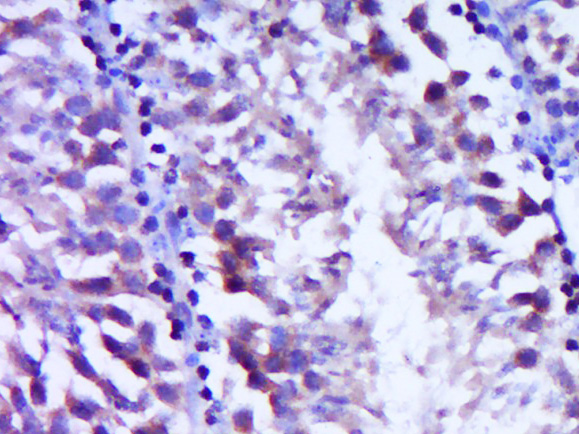
Rabbit Anti-Vitronectin antibody
Complement S Protein; Epibolin; S Protein; Serum Spreading Factor; V75; Vitronectin V10 subunit; VN; VNT; VTN; S-protein; Serum-spreading factor; V75; Vitronectin V10 subunit; VTNC_HUMAN.
View History [Clear]
Details
Product Name Vitronectin Chinese Name 玻璃粘连蛋白抗体 Alias Complement S Protein; Epibolin; S Protein; Serum Spreading Factor; V75; Vitronectin V10 subunit; VN; VNT; VTN; S-protein; Serum-spreading factor; V75; Vitronectin V10 subunit; VTNC_HUMAN. literatures Research Area Cardiovascular immunology Immunogen Species Rabbit Clonality Polyclonal React Species Mouse, (predicted: Human, Rat, Dog, Cow, ) Applications ELISA=1:5000-10000 IHC-P=1:100-500 IHC-F=1:100-500 IF=1:100-500 (Paraffin sections need antigen repair)
not yet tested in other applications.
optimal dilutions/concentrations should be determined by the end user.Theoretical molecular weight 9/52kDa Cellular localization Extracellular matrix Secretory protein Form Liquid Concentration 1mg/ml immunogen KLH conjugated synthetic peptide derived from human Vitronectin: 381-478/478 Lsotype IgG Purification affinity purified by Protein A Buffer Solution 0.01M TBS(pH7.4) with 1% BSA, 0.03% Proclin300 and 50% Glycerol. Storage Shipped at 4℃. Store at -20 °C for one year. Avoid repeated freeze/thaw cycles. Attention This product as supplied is intended for research use only, not for use in human, therapeutic or diagnostic applications. PubMed PubMed Product Detail Vitronectin (also known as serum spreading factor, S protein of complement or epibolin) is one of the major multifunctional cell adhesive glycoproteins in mammalian plasma and serum. It is a monomeric acidic glycoprotein detected as a mixture of 75 kD and 65 kD polypeptides. Vitronectin binds to heparin, collagen, streptococci and variety of cultured cells. It also acts as an inhibitor of the complement cascade by binding to the C5b9 complex. Vitronectin promotes cell adhesion and spreading by binding through its cell attachment tripeptide Arg-Gly-Asp (RG-D), activity which is mediated by several different integrin receptors. Apart from the significance for identifying the molecule in the above situations, it also plays an important role in events such as embryonal development, deposition of vitronectin in a number of fibrotic disease states, carcinomas and metastases.
Function:
Vitronectin is a cell adhesion and spreading factor found in serum and tissues. Vitronectin interact with glycosaminoglycans and proteoglycans. Is recognized by certain members of the integrin family and serves as a cell-to-substrate adhesion molecule. Inhibitor of the membrane-damaging effect of the terminal cytolytic complement pathway (By similarity).
Subunit:
Monomer. Interacts with SERPINE1/PAI1 (By similarity).
Subcellular Location:
Secreted, extracellular space.
Tissue Specificity:
Plasma.
Post-translational modifications:
Sulfated on 2 tyrosine residues (By similarity).
N- and O-glycosylated (By similarity).
It has been suggested that the active SMB domain may be permitted considerable disulfide bond heterogeneity or variability, thus two alternate disulfide patterns based on 3D structures are described with 1 disulfide bond conserved in both.
Similarity:
Contains 4 hemopexin-like domains.
Contains 1 SMB (somatomedin-B) domain.
SWISS:
P04004
Gene ID:
7448
Database links:Entrez Gene: 7448 Human
Entrez Gene: 22370 Mouse
Omim: 193190 Human
SwissProt: P04004 Human
SwissProt: P29788 Mouse
Unigene: 2257 Human
Unigene: 3667 Mouse
Product Picture
Bought notes(bought amounts latest0)
No one bought this product
User Comment(Total0User Comment Num)
- No comment



 +86 571 56623320
+86 571 56623320
 +86 18668110335
+86 18668110335

